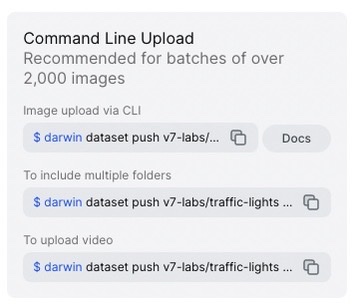Guide to slugs and identifiers in V7
In V7, we use slugs and identifiers (alphanumerical values) to uniquely identify objects such as teams, datasets, item and more. This guide takes you through some of the most important you will use and how you can find them.
Alphanumerical Identifiers
The following table details the most common alphanumerical identifiers needed for API requests and SDK methods
Identifier | Description | Where to find it |
|---|---|---|
stage_id | UUID representing a stage in a workflow | ID in stages list when calling this API request |
user_id/assignee_id | Unique id per user in your team | user_id in this API request |
team_id | Int used as identifier for your team | team_id in this API request |
dataset_id | Int used as identifier for a dataset | IDs in objects when calling this API request |
workflow_id | UUID representing a workflow | ID field in this API request |
item_id/dataset_item_id | UUID representing a dataset item | Item_ids in this API request |
annotation_classs_id | Unique int in team representing a particular class | ID field in this API request |
report_uuid | UUID for async CSV annotator item reports | ID field in this API request |
upload_id | UUID for upload | upload_id in this API request |
thread_id | UUID representing a comment thread | ID field in this API request |
comment_id | UUID representing an individual comment within a comment thread | ID field in this API request |
edge_id/edge | UUID representing an edge connecting workflow stages | ID within edges objects when calling this API request |
source_stage_id | stage_id of the source stage of an edge | source_stage_id within edges objects when calling this API request |
target_stage_id | stage_id of the target stage of an edge | target_stage_id within edges objects when calling this API request |
model_id (WIND API) | UUID representing a model register in V7 (either V7 trained or external) | ID field in this API request |
model_template_id (WIND API) | ID of the model template on which to base a TrainingSession | ID field in this API request |
running_session_id (WIND API) | The ID of a running session | ID field in this API request |
Slugs and other identifiers
Dataset Identifiers
A dataset identifier is a string that uniquely identifies a snapshot of a dataset. It is composed by 3 smaller sub-strings:
- team slug
- dataset slug
- version
And it looks like this: <team-slug>/<dataset-slug>:<version>.
Slugs here are normalized versions of the values they represent, usually without spaces and with special characters either removed or replaced with hyphens.
For our Cars dataset example in Andreas Team, the identifier for the latest version would be: andreas-team/cars:latest
See the SDK documentation on this topic
Finding Team Slugs:
Team slugs can either be found programmatically or in the UI.
In the UI
In the Command Line Upload section of the data upload pop up after push in the automatically generated commands. So In the example below, v7-labs is the team_slug:

Note: The dataset_slug will be the part after the forward slash. So in this case it would be traffic-lights
Using the SDK:
You can also run the code below using the darwin-py SDK:
from darwin.client import Client
client = Client.local()
print("Client default team slug: {}".format(client.default_team))Storage Names and Storage Slugs:
When using external storage, it is necessary to use the storage_name or storage_slug. This is the sluggified version of the Storage Name specified in your storage settings.
Team and Dataset SlugsIf you are unsure on how to generate slugs then you can use the Slugify Python library. However, underscores are not replaced with a hyphens in this case.
